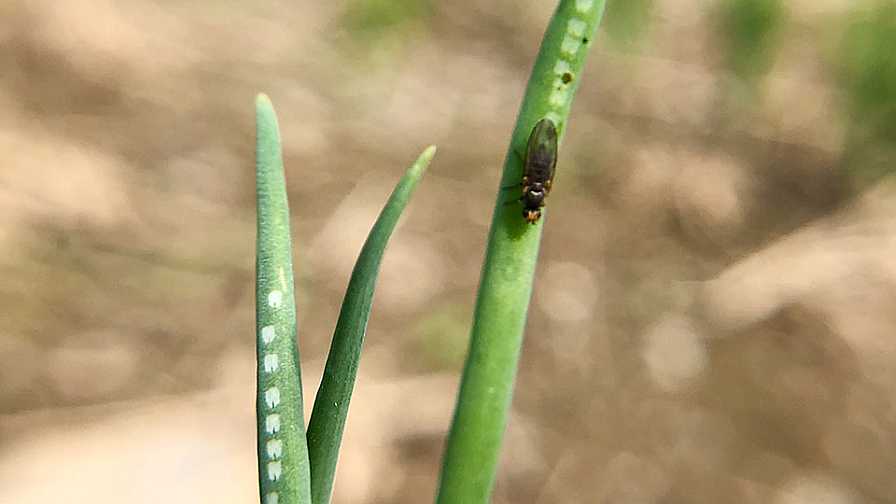Field Scouting Guide: Allium Leafminer
This month’s Field Scouting Guide concentrates on allium leafminer.
Brian A. Nault, Ph.D., Cornell AgriTech, offers tips on how to spot and treat these pests.
BASICS
- Scientific name: Phytomyza gymnostoma
- Common name: Allium leafminer
- Geographical Range: 21 countries throughout Europe; 2 countries in Asia; 1 country in North America (U.S.)
- Crops affected: Onion, garlic, leek, scallion, chive and ramps
PEST IMPACT
Nault: This is a new, invasive pest with documented presence in Connecticut, Maryland, Massachusetts, New Jersey, New York, and Pennsylvania. It was originally discovered in Lancaster County, Pennsylvania in 2015. The most severely impacted areas include Southeastern New York and Eastern Pennsylvania.
Only leek and scallion growers with small, diversified farms — especially those producing organic vegetables — have so far suffered economic losses. In a few instances, allium leafminer has destroyed entire fields of these crops. The losses come from a combination of larval feeding and subsequent establishment of bacteria and fungi that colonized the damaged crop.
In most cases, however, damage has not been this severe and occurs primarily late during the fall cropping season. To date, no economic losses have occurred in commercial dry bulb onion fields, a commodity that is highly valuable in New York.
Allium leafminer is a Dipteran (fly) that has two generations per year — one in the spring (April through early June) and one in the fall (September through November). Female flies will make egg-laying marks on leaves that can cause certain crops (scallions and chives) to be unmarketable, but only when infestations are severe and there are many marks. In most cases, the larval stage causes the most severe damage as it feeds initially inside leaves and then eventually near the base of the plant. Damaged plant tissue becomes vulnerable to bacterial and fungal infections that will destroy the crop.
RECOMMENDED TREATMENT
Nault: The highest and most consistent levels of allium leafminer control occurred using foliar applications of the traditional insecticides found in the chart. These insecticides reduced damage by 84% to 89% and reduced allium leafminer densities by 95%.
Despite the success of dinotefuran and cyantraniliprole applied as foliar sprays, neither was effective in controlling allium leafminer when administered via drip chemigation.
Spinosad applied to bare-root and plug-tray transplants immediately before transplanting reduced allium leafminer damage in the field by greater than 90%. Spinosad, however, is not currently labeled for use as a transplant treatment.
| Name | Active ingredient | Class | Mode of action | |
| Traditional chemistry | Radiant SC (Corteva) | Spinetoram | IRAC Group 5 | Nicotinic acetylcholine receptor (NACHR) allosteric modulator – Site 1 |
| Traditional chemistry | Scorpion (Gowan) | Dinotefuran | IRAC Group 4A | Nicotinic acetylcholine receptor (NACHR) competitive modulator |
| Traditional chemistry | Exirel (FMC Corporation) | Cyantraniliprole | IRAC Group 28 | Ryanodine receptor modulator |
| Organic Controls | Entrust SC (Corteva) | Spinosad | Nicotinic acetylcholine receptor (NACHR) allosteric modulator – Site 1 |
Other active ingredients that were effective, but not as consistently efficacious as the four listed above: abamectin, acetamiprid, cyromazine, imidacloprid, lambda-cyhalothrin and methomyl. Active ingredients that never controlled P. gymnostoma included the following: azadirachtin, kaolin clay, pyrethrin and spirotetramat.
IPM RECOMMENDATIONS
While insecticide effectively manages allium leafminer in a variety of allium crops, it requires weekly applications for 4 to 6 weeks. Research is currently underway to optimize insecticide use with the goal of identifying the fewest numbers of applications needed to protect allium crops from allium leafminer damage.
Allium leafminer is not an outstanding flier, so escaping the pest in space is an option. Rotating allium crops on a farm to fields located as far away as possible from previously infested allium crop fields can reduce infestations. This strategy is effective in Europe.
Because allium leafminer has two generations per season with a summer diapause (June through mid-September), there is an opportunity to escape the pest in time. Growing an allium crop in the spring and summer and harvesting by early October should escape damage by this pest.
Growing allium crops on reflective mulch has reduced the severity of allium leafminer damage in research trials in New York.
Placing row covers over allium crops during the period flies are laying eggs on leaves also may be an effective strategy.
OTHER NOTES
Allium crop growers in the Northeastern U.S. have established tolerance thresholds for densities of larvae and pupae in the marketable portion of the crop after harvest. For example, growers may remove the outermost layers of leaves from leek and scallion plants by hand, which also may remove allium leafminer larvae and pupae, leaving a blemish-free product.
These tolerance thresholds are subject to change, especially when infested produce is concomitantly diseased. Nevertheless, tolerance thresholds for allium leafminer densities in leek and scallion are approximately four and two per plant, respectively. Because allium leafminer larvae and pupae are rarely found in dry bulb onion at harvest, a tolerance threshold has not been identified.












